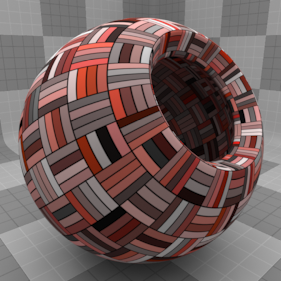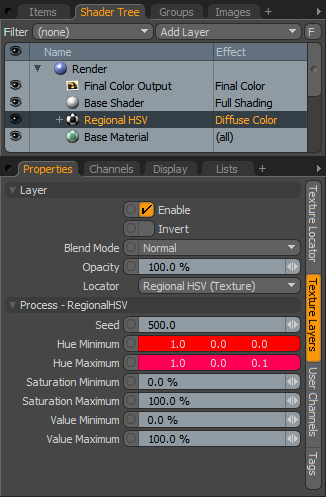
The 'Regional HSV' process layer provides users a means to control variations in e:MODO textures that output regions (such as the many 'Tiles' procedural layers). In order for the 'Regional HSV' layer to work properly, users must enable the 'Output Regions' option in the originating procedural texture layer. To use, define a layer that supports the 'Output Regions' options, enabling the 'Output Regions' option. Add the 'Regional HSV' layer set to the same effect type directly above the originating layer in the Shader Tree. Users may then adjust the 'Hue', 'Saturation' and 'Value' Min and Max settings to control the amount of variations in the regions.
For information regarding adding and working with Shader Tree Items Layers please reference the Shader Tree page of the documentation.
 Layer--
Layer--
Enable: Toggles the effect of the layer on and off, duplicating the functionality of toggling visibility in the Shader Tree. When un-checked (disabled), the layer has no effect on the shading of the scene. However, disabled layers are saved with the scene and are persistent across MODO sessions.
Invert: Inverts the RGB values for the layer producing a negative effect.
Blend Mode: Affects blending between different layers of the same effect type, allowing user the ability to stack several layers for different effects. For more on blending, please reference the 'Blend Modes' page of the documentation.
Opacity: Changes the transparency of the current layer. Reducing this value will increasingly reveal lower layers in the shader tree if present, or dim the effect of the layer itself on the surface.
Locator: Most texture layers also have an associated 'Texture Locator' that is automatically created in the 'Item List'. This defines the mapping of the texture (the way it is applied) to the surface. The 'Locator' option sets that association. While users can choose alternate locators, the need to do so will be very rare; still, there are some possible instances where users may want multiple texture items to share a single locator.
Process - Regional HSV --
Seed: The 'Seed' value is the initial number used when generating the procedural values. Different 'Seed' values will produce different random variations and can be useful in changing the texture result; however, users will want to use the same 'Seed' value when it is necessary for items to retain the same variations.
Hue Minimum: This value determines the low hue that is used to mix the final output.
Hue Maximum: This value determines the high hue that is used to mix the final output.
Saturation Minimum: This value determines the low saturation that is used to mix the final output.
Saturation Maximum: This value determines the high saturation that is used to mix the final output.
Value Minimum: This value determines the low intensity that is used to mix the final output.
Value Maximum: This value determines the low intensity that is used to mix the final output.


